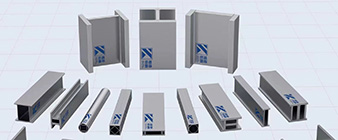Corrosion resistance:
EN 1.4401 (316) stainless steel has slightly better corrosion resistance than 316 stainless steel, especially in chloride-containing environments and more severe chemical processing conditions.
This makes EN 1.4401 (316) a better choice for structural applications in coastal, marine or highly corrosive industrial environments.
Mechanical Properties:
The mechanical properties of 316 and EN 1.4401 (316) stainless steel are generally similar, with both grades possessing good strength, ductility and toughness.
The slightly lower carbon content in EN 1.4401 (316) may result in less reduction in tensile strength and yield strength, while the difference is usually small.
Solderability:
EN 1.4401 (316) stainless steel has a lower carbon content and is slightly better weldable than 316.
This can be advantageous in the fabrication of structural beams and columns, as it helps maintain the material’s mechanical properties during the welding process.
Cost:
EN 1.4401 (316) stainless steel is generally higher grade than 316 stainless steel due to its higher alloying content, specifically the addition of chromium and molybdenum.
For structural applications in highly corrosive environments (such as coastal or marine environments) or in chemical processing facilities, EN 1.4401 (316) stainless steel is the preferred choice due to its excellent corrosion resistance.
For structural applications in less corrosive environments where cost is a more important factor, 316 stainless steel may be a more economical choice because the difference in mechanical properties is relatively small.
In both cases, the enhanceability of EN 1.4401 (316) can be an advantage in manufacturing complex structural components and assemblies.
Ultimately, the choice between 316 and EN 1.4401 (316) for structural beams and columns should be based on a careful evaluation of specific project requirements, environmental conditions and cost considerations.
-
 2024-9-16 2205 stainless steel Hollow Sections and H Sections applications
2024-9-16 2205 stainless steel Hollow Sections and H Sections applications -
 2024-9-19 1.4410 Stainless Steel Hollow Profiles Application in Water Treatment
2024-9-19 1.4410 Stainless Steel Hollow Profiles Application in Water Treatment -
 2024-9-20 Application of Ti Gr 2 / 3.7035 structural profiles in marine industry
2024-9-20 Application of Ti Gr 2 / 3.7035 structural profiles in marine industry -
 2024-9-25 SMO254 Super Stainless Steel for Structural Applications
2024-9-25 SMO254 Super Stainless Steel for Structural Applications -
 2024-9-25 Stainless Steel 430/1.4016 Structural Profiles
2024-9-25 Stainless Steel 430/1.4016 Structural Profiles -
 2024-9-20 How does high-strength S690 steel play a role in the construction field?
2024-9-20 How does high-strength S690 steel play a role in the construction field? -
 2024-9-21 S460 steel VS S690 steel
2024-9-21 S460 steel VS S690 steel



